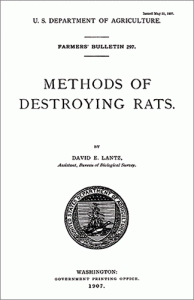This department is meant to look historically at the industry, as part of our yearlong celebration of the magazine’s 85th anniversary. But this month, we go way back — a few centuries or so.
- Photo: PMP archives
- Photo: University Of North Texas Libraries Government Documents Department
How’d we do it? The October 1953 issue of Pest Control, as Pest Management Professional was known at that time, included a full page titled “Chronology of Important Events in the History of Rats and Mice.” Compiled by Ernest Mills, who was with the U.S. Fish and Wildlife Service in New Brunswick, N.J., the foreword notes how “this list portrays how these rodents have adversely influenced the health and welfare of man and his efforts to control these pests.” Among the highlights:
- 1320 B.C. Disease epidemic (probably plague) of the Philistines during war with Israelites (Samuel I — chapters 5 and 6)
- 100 A.D. Aelianus recorded that in lower Egypt, mice were generated by raindrops. (Editor’s Note: We think Mills was referring to Claudius Aelianus, both here and two bullet points later. If so, he may be off on his timeline a bit because the Greek author is thought to have lived around 175 to 235. But Mills did not have the internet at his fingertips in 1953, so all is forgiven.)
- First Century. [Pedanius] Dioscorides recommended roast mice taken internally to check dribbling at the mouth of children.
- Second Century. Aelianus, in his De Animalium Natura, may have described the common rat.
- 1147-1223 Writings of Giraldus Cambrensis gave the first clear differentiation between rats and mice.
- 1615 Invasion of rats in Bermuda Islands caused a two years’ famine. Law passed requiring every man to keep 12 traps set.
- 1758 [Carl] Linnaeus named black rat Mus rattus and house mouse Mus musculus musculus. (Editor’s Note: Today, the scientific names are Rattus rattus and Mus musculus, respectively.)
- 1768 Publication of early famous book, The Universal Directory for taking Alive and Destroying Rats, etc., R. Smith, London.
- 1777 [J.C.] Erxleben named Norway or house rat Mus norvegicus. (Editor’s Note: Today, the genus is Rattus, not Mus, for the Norway or brown rat. “House rat” today commonly refers to roof rats.)
- 1812 Roof rat named by [Etienne] Geoffroy [Saint-Hilaire] as Mus alexandrinus. (Editor’s Note: Today, the species is known as Rattus rattus.)
- 1858 Publication of famous book The Rat by James Rodwell, London.
- 1899 Emil Zuschlag of Denmark organized the Society for Destruction of Rats with membership of 2,000 leading citizens.
- 1907 First U.S. government bulletin “Methods of Destroying Rats” by David E. Lantz. Farmers Bulletin 297. (Out of print)
- 1908 “The Incorporated Society for the Destruction of Vermin” formed in Great Britain.
- 1923 Publication of outstanding technical book on rats, Das Rattenbuch by Dr. Raphael Koller.
- 1926-9 Oven-dried process for producing red squill powder from bulbs developed by U.S. Biological Survey (now Fish and Wildlife Service).
- 1944 Sodium fluoroacetate developed by the U.S. Fish and Wildlife Service and cooperators. (Editor’s Note: Mills must have assumed we all knew the technical name of 1080, which got its name from its catalog number. The pesticide/rodenticide was canceled by the U.S. Environmental Protection Agency in 1972.)
- 1950 Anticoagulant “warfarin” developed commercially by the Wisconsin Alumni Research Foundation.
You can reach Editor Heather at hgooch@northcoastmedia.net or 330-321-9754.


Nice article Heather!
Thanks, Dan! -HG